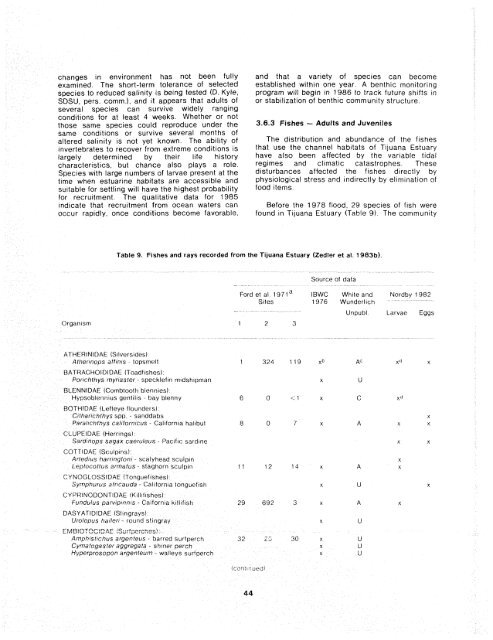The Ecology of Tijuana Estuary, California: An Estuarine Profile
The Ecology of Tijuana Estuary, California: An Estuarine Profile
The Ecology of Tijuana Estuary, California: An Estuarine Profile
Create successful ePaper yourself
Turn your PDF publications into a flip-book with our unique Google optimized e-Paper software.
changes in envlronment has not been fully<br />
examined <strong>The</strong> short-term tolerance <strong>of</strong> selected<br />
species to reduced salinity IS belng tested (D Kyle,<br />
SDSU, pers. comm), and ~t appears that adults <strong>of</strong><br />
several spectes can survcve w~dely ranglng<br />
condttcons for at least 4 weeks Whether or not<br />
those same species could reproduce under the<br />
same conditions or survlve several months <strong>of</strong><br />
altered saltn~ty IS not yet known <strong>The</strong> abcltty <strong>of</strong><br />
Invertebrates to recover from extreme condttions is<br />
largely determtned by their l~fe history<br />
characteristics, but chance also plays a role<br />
Specces wlth large numbers <strong>of</strong> larvae present at the<br />
tfme when estuarrne habitats are accessible and<br />
suitable for settlcng w~li have the h~ghest probability<br />
for recru~tment <strong>The</strong> qual~tattve data for 1985<br />
cndlcate that recruitment from ocean waters can<br />
occur rap~dly, once cond~tions become favorable,<br />
and that a variety <strong>of</strong> species can become<br />
established within one year. A benthic monitoring<br />
program will begin in 1986 to track future shifts in<br />
or stabilization <strong>of</strong> benthic community structure.<br />
3.6.3 Fishes - Adults and Juveniles<br />
<strong>The</strong> distribution and abundance <strong>of</strong> the fishes<br />
that use the channel habitats <strong>of</strong> <strong>Tijuana</strong> <strong>Estuary</strong><br />
have also been affected by the variable tidal<br />
regimes and climatic catastrophes. <strong>The</strong>se<br />
disturbances affected the fishes directly by<br />
physiological stress and indirectly by elimination <strong>of</strong><br />
food items.<br />
Before the 1978 flood. 29 species <strong>of</strong> fish were<br />
found in <strong>Tijuana</strong> <strong>Estuary</strong> (Table 9). <strong>The</strong> community<br />
Table! 9. Fishes and rays recorded from the <strong>Tijuana</strong> <strong>Estuary</strong> (Zedler et al. 1983b).<br />
Organlsrn 1 2 3<br />
Unpubl 1-drvae Eggs<br />
Alk4tAINIOAT (Sllverstdes)<br />
Attrsrrr!oy>s aiftnis tupsrnt4t 1 324 119 xD Ac xd x<br />
RA I"C{ACHOlOIDAE (loadfishes)<br />
Portchthys inyrtesfer - specklellri rn~dsti~pman x U<br />
BLENNIUAF (Cornbtrjoth bltlr-irj~t?~)<br />
Wypsoblenrl~us genlilis bay blenriy 6 0 - 1 x C xd<br />
BOT MDAF (t-efteye fluundersi<br />
C~thartchff?yspp - siincldabs<br />
x<br />
Parcll~Cilfttys cahlurntctrs - Caltforr~ta halibut 8 0 7 x A x x<br />
C:I.UPFIDAt:<br />
{Neru~irqs)<br />
Serdinops saqax caeruloos - Pac~fic<br />
sardine x x<br />
CC37"7 IDAC (Sc:cilpnsi<br />
Arfsdrus harrifrqtr>rr~ - scaiyhead sculpin x<br />
L~pt~i(:<strong>of</strong>fu~ arrncltus stacgllnrn scul~tn 11 12 14 x A x<br />
C:YNUGLUSSIDAE (I'onguef~st~es)<br />
Symnpltcj~us arr~cauda - Calrforn~a Iongueflsl~ x U<br />
CYPUINODCTNTl[IAE (Kiilll~shes)<br />
Furidulus parvtprnrrts - Calfarn~a k~li~fish 29 692 3 x A x<br />
DASYATlDlUAE (Sl~rigrays)<br />
Urolopus rrdlferi - roilrid st~ngray x U<br />
f :dB:OTrSCtDAt !Surfpcrckcs!<br />
Amph~sttchus argenteus - barred<br />
.- *-<br />
surfperch 32 C ., 30 x U<br />
Cymatogaster aggregata - shrner perch x U<br />
Hyper~rosopon arqenteum - walleys surfperch x U<br />
(cO'111~:uoCII<br />
44

















